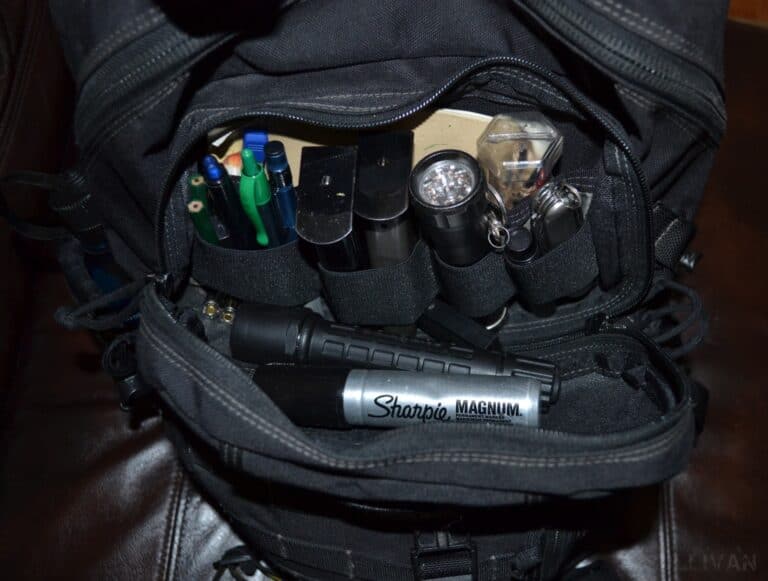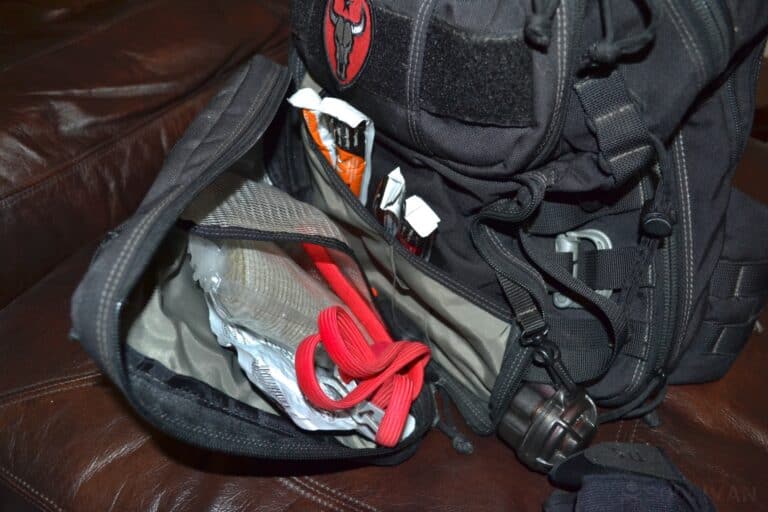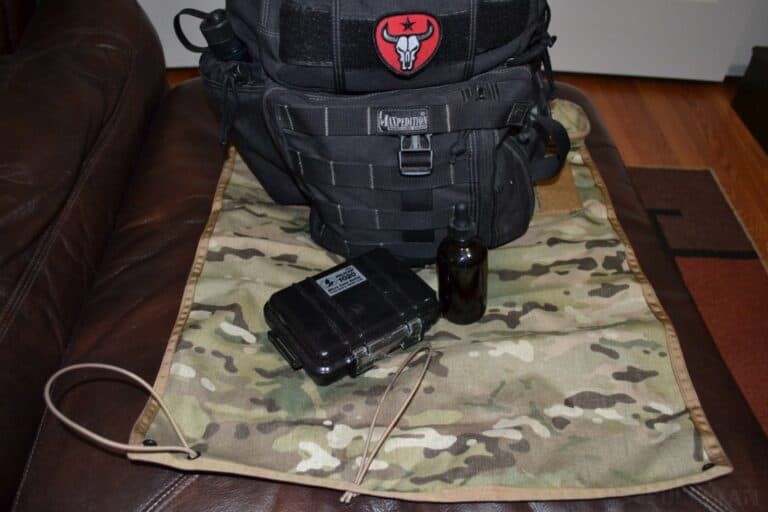You’ve probably thought a lot about what you’re going to do when the time comes to run away from a bad situation.
The notion of abandoning your home and heading for safer ground when things get really desperate is something of a trope in prepping. But have you considered the fact that you’ll need to get home before you’ll be able to do anything else during a bad situation?

Chances are, as a functional adult, you spend many of your waking hours away from home, and that means you’ll need to make tracks and head for home as quickly as possible. To do that, you’ll need some gear and supplies for the journey; a get-home bag.
What is a get-home bag? It’s a backpack containing gear, equipment, and a few supplies to help a person who is forced to get home under duress do so more easily, and with the best chance of survival and success. Compared to a bug-out bag, a GHB is typically smaller, lighter, and not as well equipped.
Putting together your own get-home bag is not difficult, but doing it properly with an eye towards efficiency, lightweight and minimalism can be challenging if you have spent much of your prepping career considering only how to pack a bug-out bag full of as much stuff as you can physically carry.
Keep reading, and I’ll provide you with a little bit to think about for preparing your own GHB.
The Situation May Not Begin With You at Home
If there is one fallacy I see pop up again and again in the context of SHTF situations and specifically disaster avoidance it is the notion that your journey will begin while you are at home.
Everything you see written on the subject, pretty much, will essentially be written from the standpoint that you and yours are waiting at home for the “starting gun” to go off, like a bunch of firemen waiting at the station for the call. It is likely that isn’t going to be the case much of the time.
Why? Think about it: How much time do you spend outside your home taking care of work, errands, commuting, activities, and all that stuff? Probably a good bit. Now multiply this factor by however many people are in your family that have lives of their own outside the home.
If your significant other has a job of their own, they’ll be in the exact same boat, and to a lesser degree so will your children who are still in school.
These highly varied and variable itineraries further compound your possible responses based on how capable or incapable your family members are. Things are getting tricky fast!
Now, consider the fact that you might have commuted to work, but you won’t be able to take a vehicle home. You’ll have to walk and still try to make good time while avoiding innumerable obstacles and hazards. Wouldn’t you be better off if you had a small but reliable stash of gear with you? That is where the GHB comes in.

Get-Home Bag Loadout
The contents of the average get-home bag are probably not going to contain too many mysteries or surprises for seasoned preppers. You’re going to see plenty of items on the list I’m about to share with you that would be right at home in any BOB or INCH bag.
So what’s the difference between the get-home bag and these other bags? Is it just a survival bag by any other name? Not exactly, and the difference is purpose.
Yes, all of these bags are intended to keep you alive, keep you functional, and putting in the work you need to in order to secure a good outcome for yourself and your loved ones, but it is the context in which the bags will be used that dictates how they are set up.
Remember, it is always the mission objective that determines the gear choices. The characteristics of your gear are either in service of your mission objective, or they aren’t, and we definitely want to make sure that they are!
Since the purpose of a get-home bag is to give you just enough equipment and supplies, so that you can keep moving at a good clip and get home as quickly as possible (on what is quickly becoming the worst day of your life) it makes sense that the bag and the items it carries should be as lightweight, low profile and minimalist as possible.
You want to be moving quickly at a time like this, as you probably aren’t worried about sustaining yourself in the field for days at a time.
For that reason, the typical load will either be minimalist versions of gear selections you are used to seeing in other bags or drastically reduced amounts of various supplies. Speed is the rule of the day, and the load of your GHB must reflect that!
Typical inclusions are:
First-Aid Kit: You’re going to need this bag during a major situation. You could be starting out injured, or get injured on the way home. Your first aid kit must include what you need to treat minor injuries as well as trauma.
Knife: No prepper, anywhere, anytime should be caught without a knife. A sturdy, fixed-blade knife should be an auto-include in your get-home bag. It is an invaluable tool and might wind up being a weapon you are forced to rely on.
Multi-tool: Disaster situations mean things are going to get broken. Hedge your bets on repairing or tinkering with anything that is presenting an obstacle or malfunctioning gear by including a versatile and lightweight multi-tool.
Space Blanket: You’ll notice that most get-home bags skimp on substantial shelter items, and this one is no different. But a lightweight, crinkly space blanket will do a great job of keeping you warm when you have to stop for rest and they weigh next to nothing.

Tarp, Cord, Zip Ties: Skip the tent or bivy and carry a large, durable, and lightweight tarp with you in your get-home bag along with cordage and zip ties. This will allow you to fashion a shelter pretty much anywhere you happen to be, or use it as a ground cover as called for should you need to overnight.
Flashlight: Just like the knife, no prepper should ever be without a flashlight. Make sure yours strikes a balance between size, output, and run time. Include a couple of sets of extra batteries.
Headlamp: Flashlights are great, but sometimes you need your hands free, and holding one between your teeth flat out sucks. Headlamps are the ultimate and hands-free convenience lighting. Bonus points if this shares batteries with your flashlight.
Snaplights: Yet another lighting system, but one that is worthy of inclusion because it is a value-added inclusion. Safe, heatless, flameless, and ideal for marking or soft area lighting. These are good to have and weigh very little.
Fire-Starter: Another prime consideration for all preppers. The ability to make a fire is invaluable when you need one, so make sure you include two lightweight options in your GHB. I prefer a Ferro rod backed up by a couple of disposable butane lighters.
Map and Compass: Never, ever trust that the landscape will be recognizable in the aftermath of the event or that your GPS and your vehicle or your phone will continue to function. A map and compass will provide for basic navigation and direction finding.
Clothing: You should include a small stash of clothing in your get-home bag according to what you typically wear when you are out of the house. At the minimum, make sure you include a set of footwear suitable for walking long distances, and a pair of sturdy gloves to protect your hands.
If you typically dress in such a way for work that you’ll be prohibited from moving easily, or being afforded much protection from the environment include a full change of clothes. The expectation is that you will ditch the clothing you were wearing when you change to save weight.
Food: Keeping up your energy is going to be important when heading home. Standard trail food like beef jerky, energy bars, hard candy, and other zero-prep, easy-to-eat items are a good idea.
Water: Water is essential, even for such a short movement as what you are likely to face heading home during a crisis. At the very least, you should include a large Nalgene bottle full of water to stay hydrated since you are going to be hustling.
If there are plenty of water sources along your projected routes, toss in an ultra-compact water filter so you can refill along the way. If water is scarce pack a second water bottle.
Conclusion
The get-home bag is a small backpack full of just enough supplies and gear to reasonably support you while you make tracks for home during a crisis.
Considering how likely it is you’ll be away from your home at the start of any big disaster or other SHTF moment, you’ll definitely want to keep a GHB at your office or in your vehicle!

Tom Marlowe practically grew up with a gun in his hand, and has held all kinds of jobs in the gun industry: range safety, sales, instruction and consulting, Tom has the experience to help civilian shooters figure out what will work best for them.

Not bad if you’re within walking distance of home, although there was no mention of a firearm and extra ammo. I’d throw in some extra cash or silver too.
Not so good if you travel for business. Many people are looking at a multi-week hike/camp to get home, feeding themselves along the way.